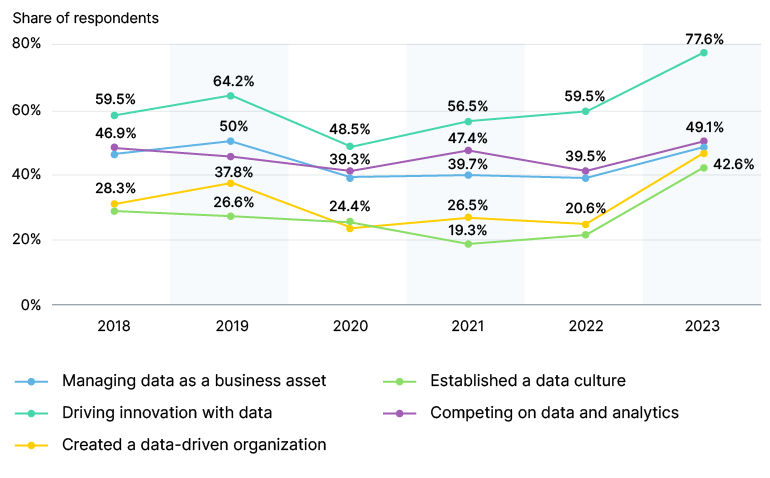Businesses of today are well aware that if you don’t use your data, you lose. A data error was at the core of the Wells Fargo scandal resulting in denied loans to hundreds of customers and causing the bank millions of dollars in remediations. Netflix, on the other hand, has data-driven recommendations for each member of your family and continues to dominate the market, with only a 2% customer churn rate. A key force for driving decisions, accelerating processes and powering predictions, data has become the foundation companies must have in order to grow and offer the experience their customers expect.
With data becoming a key component of business flows in all industries, the market for tools and technologies that help organizations collect, process, and analyze data is booming. Edge computing, artificial intelligence, data mesh – anything that allows for harnessing data and deriving useful insights from it is being actively developed, enhanced, and adopted across multiple industries.
The share of businesses that have adopted data analytics and related technologies is also steadily growing. According to Statista, 77% of organizations worldwide use big data to drive innovation, while about 50% rely on data to improve their competitiveness.
Big data and AI adoption by companies worldwide

Source: Statista
This focus on data analytics has shaped a number of data trends that are likely to be carried forth into 2026 and beyond and propel the creation of innovative data solutions. In this post, we take a closer look at the main factors driving data analytics.
Increased adoption of real-time analytics
In real-time analytics, or stream analytics, data is analyzed continuously as it is received from the source. This method is preferred for cases when data is time-sensitive and delays in results may be critical. With real-time analytics, insights are generated promptly, allowing for timely business decisions.
Growth of real-time analytics is driven by the rising adoption of Internet of Things and edge computing. Complex systems of sensors, cameras, and other streaming devices require continuous processing of data to identify patterns and deviations and take necessary actions. Using tools such as Kafka, Spark, or Kinesis, these systems can process and analyze large volumes of streaming data from multiple sources.
Real-time analytics is often used in applications that monitor equipment or environmental conditions and alert the personnel of irregularities. For example, this technology is at the core of a solution that monitors the temperature of freezers and refrigerators at retail chain locations and notifies technicians when the temperature is too high or too low. This way, employees can act quickly to prevent food from spoiling.
Focus on data governance
As data gains more and more prominence in business processes, standardization to ensure data security, quality, and compliance becomes necessary. This is what data governance is about.
Data governance comprises a set of policies and procedures related to data access, sharing, privacy, and regulatory compliance. In an analytical process, it is critical to ensure a high level of data quality and reliability. For example, in 2020, about 16,000 positive COVID cases did not make the official statistics in Public Health England due to the incorrect file format. Thus, businesses need to focus on establishing standards aimed at maintaining the integrity and consistency of data and protecting it from violations.
For businesses managing large amounts of data coming in different formats from multiple sources, data governance is a must, particularly when that data is sensitive. For example, an integrated data governance framework was the optimal solution for a telecommunication services provider concerned about data security in outsourced applications. The platform Intellias helped the telecom implement streamlined data management, establishing unified rules and procedures, ensuring security, and maintaining compliance.
Data mesh to boost analytics efficiency
An alternative to traditional centralized data management architectures, data mesh represents a distributed, decentralized framework that ingests data from different sources and processes it in a domain-oriented architecture. This approach allows for data processing by multiple domain experts, avoiding the bottleneck of a central team.
In a mesh architecture, data analytics generates higher-quality results within a shorter time frame due to more efficient data pipelines without a single central storage location. At the same time, data governance policies and standards are common for all domains, ensuring compliance and security.
The advantages of a data mesh are recognized in many industries. For example, Roche, a biotech and diagnostics company, uses data mesh as one of the technologies for boosting its digital transformation. The company processes massive amounts of data, and data mesh enables real-time analytics and allows it to achieve better results.

Advance of AI- and ML-powered data analytics
One of the latest data analytics trends is the growing focus on AI and ML. Artificial intelligence and machine learning are disrupting and transforming processes in many industries automating manual tasks, detecting minor trends, and analyzing massive datasets.
Data analysts use ML models to monitor incoming data in real time, finding deviations and anomalies and alerting operators about them. From healthcare and telecom to retail and finance, organizations in virtually every industry can benefit from advanced analytics, forecasting, and optimization based on results of data processing by AI and ML algorithms.
One such algorithm for AI object detection and recognition was used in the development of an AI-/ML-powered solution for autonomous vehicles. This highly technological project is based on stereoscopic vision and AI/ML algorithms providing outstanding accuracy of object detection, carrying significant potential for the global adoption of self-driving vehicles.
DataOps to improve the quality of analytics
DataOps, standing for Data Operations, streamlines data pipelines along the entire data management cycle, improving the speed and quality of data processing and fostering collaboration. DataOps changes the very culture of data analytics, bringing effective automation to processes and encouraging continuous use of data.
DataOps practices allow companies to form coherent data pipelines that transport and transform data along its journey from source to destination, accelerating its delivery while maintaining security and regulatory compliance. As a result, businesses benefit from a higher quality of insights and shorter processing times.
A prominent case of DataOps pipeline implementation is a data flow transformation for a global food retailer. The business uses an integrated data management platform to synchronize data between systems and enable process monitoring across the entire enterprise infrastructure.
The importance of data democratization
As data becomes an insight-generating asset for all functions within an organization, a question of accessibility arises. What was previously the domain of data scientists armed with specialized training and skills is transforming into a field a much wider audience can access.
Companies usually adopt a multi-faceted approach to data democratization. They simplify data stacks, implement tools enabling non-technical people to work with data, and invest in special training for their employees to help them unlock data analytics and its opportunities.
In facilitating access to data, companies leverage various tools and technologies such as generative AI to extract insights, data fabric to connect data processing infrastructures with user-facing applications, and data mesh to implement a domain-centered architecture. At the same time, users can benefit from self-service resources: dashboards representing data in a visual format, knowledge bases, and testing tools.
The principle of data democratization was at the core of a data management solution implemented for a loan management company. The analytical platform for processing customer data included self-service options that allow employees to use insights generated by data analytics in their work.
Extended use of edge analytics
As the Internet of Things and edge computing gain traction, the benefits of processing and analyzing data close to its source are becoming increasingly apparent, turning into one of the data analytics trends worth following. With IoT networks becoming more complex and widespread, bringing analytics to the edge improves the quality of data management while reducing operational costs.
Edge analytics can decrease latency in an IoT system, accelerating decision-making. This can be especially valuable in real-time monitoring applications, where timely detection of deviations can prevent failures, reduce downtime, and lower costs.
This approach is used in a predictive maintenance solution for industrial enterprises – an intelligent platform for collecting, processing, and analyzing data from multiple sensors distributed across enterprise premises and monitoring equipment. Analytical algorithms detect deviations from the norm and notify operators in real time, allowing them to take preventive measures.

Rising popularity of hybrid cloud computing
A hybrid cloud is a solution for those who don’t want to choose between cloud and on-premises infrastructures – they can enjoy the benefits of both approaches. The flexibility of deciding which resources to use for services, applications, and data management gives a powerful boost to overall performance.
For data analytics, hybrid cloud computing means maximum access to data whenever it is needed. At the same time, seamless integrations between cloud and on-premises components prevent data silos, enabling comprehensive analysis and detailed insights.
The hybrid approach was used in cloud migration for City Plumbing Suppliers, where the legacy platform was updated and integrated with cloud-based infrastructure to provide advanced services. This way, the business makes the most of both on-premises and cloud environments, benefiting from improved performance and scalability.
Natural language processing (NLP) driving business intelligence
A rapidly developing branch of AI, natural language processing is quickly gaining traction with businesses focused on improving their business intelligence and data analytics processes. By enabling computers to parse and interpret human language, NLP has become a key component in applications processing unstructured data, such as social media content or emails.
Growing adoption of NLP is one of the data analytics trends that is shaping the way data is used in sales and marketing. One area of data analytics where NLP is especially effective is sentiment analysis, or opinion mining. NLP algorithms are used to determine whether the tone of the analyzed text is positive, negative, or neutral. This technique is often used in sales and marketing to assess the efficiency of campaigns, evaluate product and brand positioning, and get insights into customer expectations.
For an example of NLP use for sentiment analysis, let’s look at a solution for a company providing business consulting services. The business’s offering was enhanced with an AI-powered tool for scanning public media and communication channels and evaluating the performance of a particular brand. NLP technology at the core of the solution supplies data that allows the company to better understand the brand’s reputation and generate improvement recommendations.
Flexibility as key to embracing data analytics trends
Adopting technology that allows you to maximize the usefulness of your data may be the key to your business’s success. That is why, as approaches in data management are shaped and reshaped, we need to be prepared to embrace the latest trends in data analytics that boost its efficiency and productivity as well as the quality of data insights.
Today, data analytics is powered by the latest innovations in artificial intelligence, DataOps, hybrid cloud computing, and edge networks. Tomorrow, it may be some new technology. Businesses that stay agile and flexible and are prepared to change and adapt will be the first to the finish line in this accelerating data race. Intellias is happy to support you on your data journey and help you embrace innovations that propel you to success.


